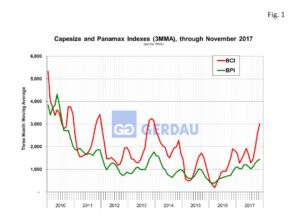The Baltic Dry Index
The three month moving average (3MMA), of the Baltic Dry Index (BDI), for November moved-up 7.7% to 1,434 month on month (m/m). The index has moved higher in each of the last four months, (3MMA). On a 3MMA year on year basis, (y/y), the BDI was 55.4% higher. The BDI has averaged 1,112 over the past 12 months, ranging from a low of 759 to a high of 1,484.
The BDI is a shipping and trade index created by the London-based Baltic Exchange that measures changes in the cost to transport raw materials. The Baltic Dry Index offers a forward view into global supply and demand trends. A rising index can indicate a strengthening global economy. A contracting BDI index signals a slow-down.
The BDI includes three component ships: Capesizes, Panamaxes and Supramaxes. Capesize ships are the largest at >100,000 dead weight tons, (DWT). Capesize vessels make up 10% of the world fleet but account for 62% of dry bulk traffic. Panamaxes account for the vast majority of steel and its raw material freight, they weight in the range of between 60,000 to 80,000 DWT. Panamaxes account for 19% the world fleet and 20% of dry bulk traffic. Supramaxes (35,000 to 59,000 DWT), make-up 37% of the world fleet and combined with the smallest Handyman vessels (15,000 to 35,000 DWT), which account for 34% of the world fleet tally the remaining 18% of dry bulk traffic. Handymaxs are not counted in the BDI index.
 Figure 1 shows the 3MMA for both Capsize and Panamax indexes. These volatile indexes have both been trending higher since early 2016. Despite the recent rise, the BDI is still quite low by historic comparison. The November Capsize (BCI), 3MMA was up 15.5% and up 58.1% y/y. The November Panamax (BPI), 3MMA was up 3.8% and up 61.7% y/y. As a point of reference the BCI is currently 92.3% lower than its peak in April of 2008, while the BPI is down 87.8% from the April 2008 high.
Figure 1 shows the 3MMA for both Capsize and Panamax indexes. These volatile indexes have both been trending higher since early 2016. Despite the recent rise, the BDI is still quite low by historic comparison. The November Capsize (BCI), 3MMA was up 15.5% and up 58.1% y/y. The November Panamax (BPI), 3MMA was up 3.8% and up 61.7% y/y. As a point of reference the BCI is currently 92.3% lower than its peak in April of 2008, while the BPI is down 87.8% from the April 2008 high.
The Baltic Dry Index climbed to a three year high in November, as the demand and hence prices of many industrial commodities, (such as coal, iron ore, grain) moved higher. China is the world's leading commodities consumer. When China buys, prices tend to rally. Since dry bulk is primarily raw material input to the production of intermediate or finished goods, the BDI is viewed as an efficient economic indicator of future economic growth and production. The fact that the BDI is moving higher indicates that the global commodity market is gaining strength.
At Gerdau we regularly monitor the Baltic Dry index since it is a leading indicator of demand for goods on a global scale. An increasing BDI signals stronger global trade which can be good for domestic business if the transactions are fairly traded.

